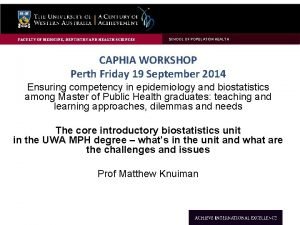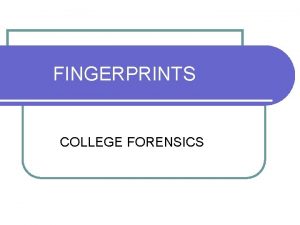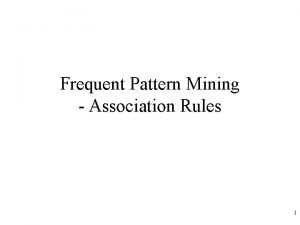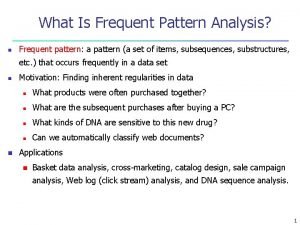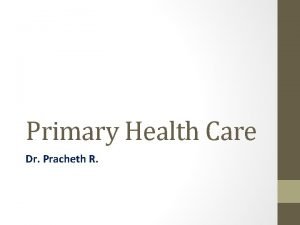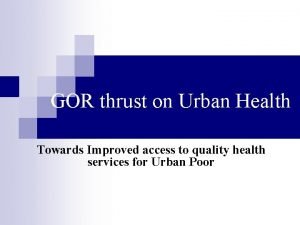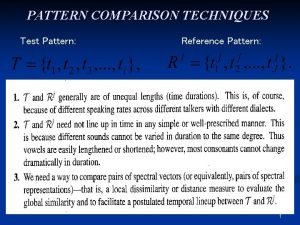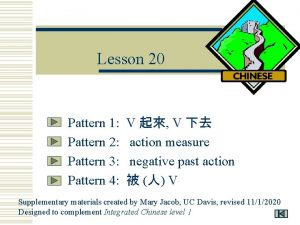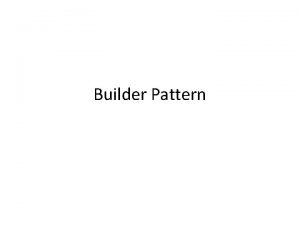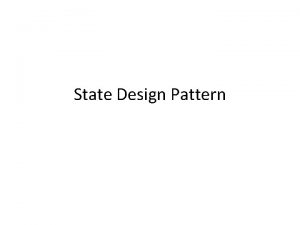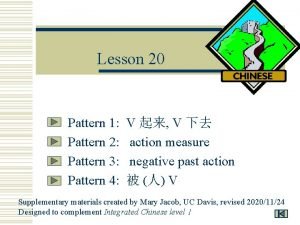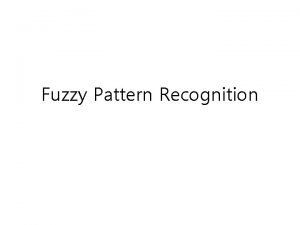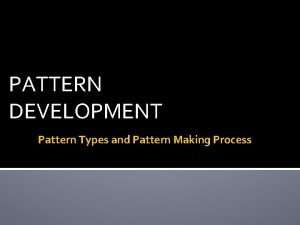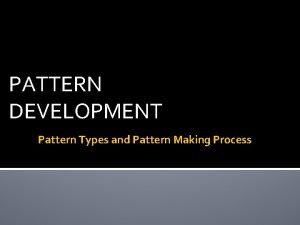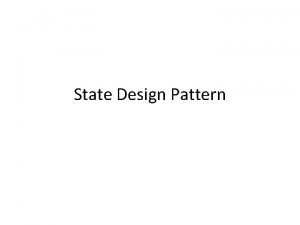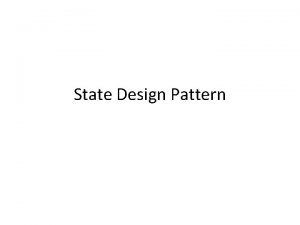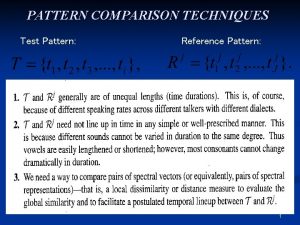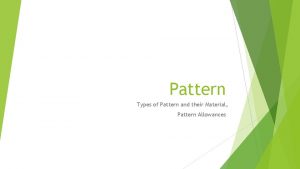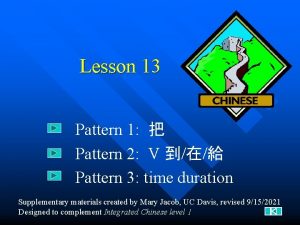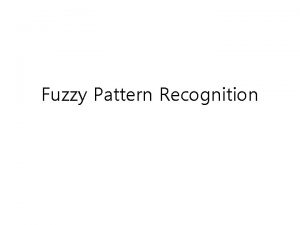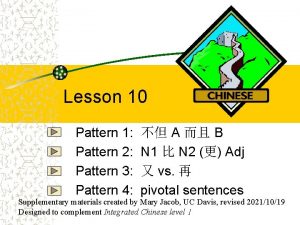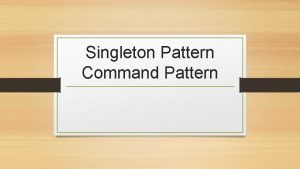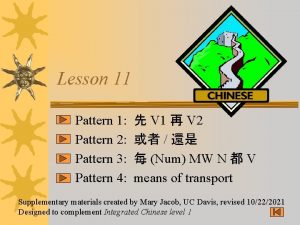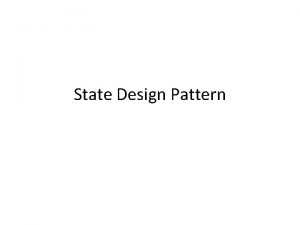Chapter 3 Functional Health Pattern Faculty of NursingIUG





































- Slides: 37

Chapter (3) Functional Health Pattern Faculty of Nursing-IUG

Definition of (NANDA) The North American Nursing Diagnosis Association (NANAD 1994) defines a nursing diagnosis as “A clinical judgments about individual, family or community response to actual and potential health problems and life responses” 2

Functional health pattern (NANDA) 3 1 - Health Perception-Health Management Pattern 2 - Nutritional—Metabolic Pattern 3 - Elimination Pattern 4 - Activity—Exercise Pattern 5 - Sexuality—Reproduction Pattern 6 - Sleep—Rest Pattern 7 - Sensory—Perceptual Pattern 8 - Cognitive Pattern 9 - Role—Relationship Pattern 10 - Self-Perception-Self-Concept Pattern 11 - Coping-Stress Tolerance Pattern 12 - Value—Belief Pattern

Health Perception-Health Management Pattern 1 - Determine how the client perceives and manages his or health. 2 - Compliance with current and past nursing and, medical recommendations. 3 - The client's ability to perceive the relationship between activities of daily living and health. 4

Subjective Data 5 Client's Perception of Health: Describe your health. Client's Perception of Illness Describe your illness or current health problem. Health Management and Habits Tell me what you do when you have a health problem. Compliance with Prescribed Medications and Treatments Have you been able to take your prescribed medications? Objective Data If. Refer not, to what caused your Survey inability to do so? General Physical

Associated Nursing Diagnoses Wellness Diagnoses Effective Management of Therapeutic Regimen Risk Diagnoses Risk for Injury Risk for Suffocation Risk for Trauma Actual Diagnoses Altered Growth and Development Ineffective Management of Therapeutic Regimen: Individual Ineffective Management of Therapeutic Regimen: Family 6 Ineffective Management of Therapeutic Regimen:

Nutritional-Metabolic Pattern Assessing the client's nutritional-metabolic pattern is to determine the client's dietary habits and metabolic needs. The conditions of hair, skin, nails, teeth and mucous membranes are assessed. Subjective Data Dietary and Fluid Intake Describe the type and amount of food you eat at breakfast, lunch, and supper on an average day. Do-you take any vitamin supplements? Describe. Do you find it difficult to tolerate certain foods? Specify. Do you ever experience nausea and vomiting? Describe. Do you ever experience abdominal pains? Describe. 7

Condition of Skin Describe the condition of your skin. How well and how quickly does your skin heal? Do you have any skin lesions? Describe. Do you have any itching? What do you do for relief? Condition of Hair and Nails Have you had difficulty with scalp itching or sores? Do you use any special hair or scalp care products? Have you noticed any changes in your nails? Color Cracking? Shape? Lines? 8

Metabolism What would you consider to be your "ideal weight"? Have you had any recent weight gains or losses? Do you have any intolerance to heat or cold? Have you noted any changes in your eating or drinking habits? Explain. Have you noticed any voice changes? Objective Data Assess the client's temperature, pulse, respirations, and height and weight. 9

Wellness Diagnoses 0 pportunity to enhance nutritional metabolic pattern Opportunity to enhance effective breastfeeding Opportunity to enhance skin integrity Risk Diagnoses Risk for Altered Body Temperature Hypothermia Risk for Infection Risk for altered nutrition less than body requirements. Risk for Aspiration 10

Actual Diagnoses Fluid Volume Deficit Fluid Volume Excess Altered Nutrition: Less than body More than body requirements Altered Nutrition: requirements Ineffective Breastfeeding 11

Elimination Pattern Adequacy of the client's bowel and bladder. The client's bowel and urinary habits. Bowel or urinary problems. Use of urinary or bowel elimination devices. 12

Subjective Data Bowel Habits How frequent are your bowel movements? Do you use laxatives? What kind and how often do you use them? Do you use enemas or suppositories? How often and what kind? Do you have any discomfort with your bowel 13 movements? Describe.

Bladder Habits How frequently do you urinate? What is the amount and color of your urine? Do you have any of the following problems with urinating: ü Pain? Blood in urine? Difficulty starting a stream? Incontinence? Voiding frequently at night? Voiding frequently during day? Bladder infections? ü Have you ever had a urinary catheter? Describe. When? How long? Objective Data Refer to abdominal assessment, and the rectal 14 assessment.

Associated nursing-Diagnoses Wellness Diagnoses Opportunity to enhance adequate bowel elimination pattern Opportunity to enhance adequate urinary elimination pattern Risk Diagnoses Risk for constipation 15 Risk for altered urinary elimination

Actual Diagnoses Altered Bowel Elimination Constipation Diarrhea Bowel Incontinence Altered Urinary Elimination Patterns of Urinary Retention Total Incontinence Stress Incontinence 16

Activity-Exercise Pattern Activities of daily living, including routines of exercise, leisure, and recreation. Activities necessary for personal hygiene, cooking, shopping, eating, maintaining the home, and working. An assessment is made of any factors that affect or interfere with the client's routine activities of daily living. 17

Subjective Data Describe your activities on a normal day (Including hygiene activities, eating activities). Do you have difficulty with any of these self-care activities? Explain. Does anyone help you with these activities? How? Do you use any special devices to help you with your activities? Does your current physical health affect any of these activities e. g. dyspnea, shortness of breath, palpations, chest pain, stiffness, weakness)? Explain. Occupational Activities Describe what you do to make a living. Do you feel it has affected your health? 18

Objective Data Refer to Thoracic and Lung Assessment Cardiac Assessment Peripheral Vascular Assessment Musculoskeletal Assessment Associated Nursing Diagnoses Wellness Diagnoses Opportunity to enhance effective cardiac output Opportunity to enhance effective self-care activities Opportunity to enhance adequate tissue perfusion Opportunity to enhance effective breathing pattern 19

Risk Diagnoses Risk for Disorganized Infant Behavior Risk for Peripheral Neurovascular Dysfunction Risk for altered respiratory function Actual Diagnoses Activity Intolerance Impaired Gas Exchange Ineffective Airway Clearance Ineffective Breathing Pattern Disuse syndrome Impaired Physical Mobility Inability to Sustain Spontaneous Ventilation 20 Altered Tissue Perfusion

Sexuality-Reproduction Pattern Subjective Data 1 - Female Menstrual history: Last cycle begin? Duration ? Any change or abnormality ? Describe any mood changes or discomfort before, during, 21 or after your cycle

Obstetric history How many times have you been pregnant? Describe the outcome of each of your pregnancies. If you have children, what are the ages and sex of each? Explain any health problems or concerns you had with each pregnancy. If pregnant now. Contraception What do you or your partner do to prevent pregnancy? Describe any discomfort or undesirable effects this method produces. 22

Special problems Do you have or have you ever had a sexually transmitted disease? Describe any pain, burning, or discomfort you have while voiding. Objective Data Refer to Breast Assessment, d Abdominal Assessment, and urinary-Reproductive Assessment 23

Associated nursing Diagnoses Wellness Diagnosis: Opportunity to enhance sexuality patterns Risk-Diagnosis Risk for altered sexuality pattern Actual Diagnoses Sexual Dysfunction, Altered Sexuality Patterns 24

Sleep-Rest Pattern Subjective data Sleep Habits: How would you rate the quality of your sleep? Special Problems Do you ever experience difficulty with falling asleep? Remaining asleep? Do you ever feel fatigued after a sleep period? Sleep Aids What helps you to fall asleep? medications? reading? relaxation technique? Watching TV? 25 Listening to music?

Objective Data 1. Observe appearance a. Pale b. Puffy eyes with dark circles 2. Observe behavior a. Yawning b. Dozing during day c. Irritability d. Short attention span 26

Associated nursing Diagnoses Wellness Diagnosis: Opportunity to enhance sleep Risk Diagnosis Risk for sleep pattern disturbance Actual Diagnosis: Sleep Pattern Disturbance. 27

Sensory-Perceptual Pattern Subjective Data Describe your ability to see, hear, feel, taste, and smell. Describe any difficulty you have with your vision, hearing, and ability to feel (e. g. , touch, pain, heat, cold), taste (salty, sweet, bitter, sour), or smell. Pain Assessment Complete Symptom Analysis Special Aids: What devices (e. g. , glasses, contact lenses, hearing aids) Describe any medications you take to help you with these problems. 28 Objective Data

Associated Nursing Diagnoses Wellness Diagnosis: Opportunity to enhance comfort level Risk Diagnoses Risk for pain Actual Diagnoses Pain 29

Cognitive Pattern Subjective Data Ability to Understand: Explain what your doctor has told you about your health. Ability to Communicate: Can you tell me how you feel about your current state of health? Ability to Remember: Are you able to remember recent events and events of long ago? Explain. 30 Ability to Make Decisions:

Objective Data Refer to the Mental Status Assessment Associated nursing Diagnoses Wellness Diagnosis: Opportunity to enhance cognition Risk Diagnosis: Risk for altered thought processes Actual Diagnoses: 31 Acute confusion Chronic Confusion

Role-Relationship Pattern Subjective Data Perception of Major Roles and Responsibilities in Family Describe your family. Are there any major problems now? Perception of Major Roles and Responsibilities at Work Describe your occupation. What is your major responsibility at work? Perception of Major Social Roles and Responsibilities 32

Objective Data 1. Outline a family genogram for your client. 2. Observe your client's family members. Associated Nursing Diagnoses Wellness Diagnoses: Opportunity to enhance effective relationships Opportunity to enhance effective communication Risk Diagnoses: High risk for Loneliness Risk for Altered Parent/Infant/Child Attachment Actual Diagnoses: Impaired Verbal Communication Impaired Social Interaction: Social Isolation 33

Coping-Stress Tolerance Pattern Subjective Data Perception of Stress and Problems in Life Describe what you believe to be the most stressful situation in your Life. How has your illness affected the stress you feel? Coping Methods and Support Systems: What do you usually do first when faced with a problem? What helps you to relieve stress and tension? Do you use medication, drugs, or alcohol to help relieve stress? Explain. Objective Data 34 Refer to the Mental Status Assessment.

Associated nursing Diagnoses Wellness Diagnoses Opportunity to enhance effective individual coping. Opportunity to enhance family coping Risk Diagnoses: Risk for self-harm Risk for suicide Actual Diagnoses: Ineffective Individual Coping Ineffective Family Coping: Disabling 35

Value-Belief Pattern Subjective Data Values, Goals, and Philosophical Beliefs Religious and Spiritual Beliefs: Are there certain health practices or restrictions that are important for you to follow while you are ill or hospitalized? Explain. Objective Data 36 Observe religious practices Bible , clergy Observe client's behavior for signs of spiritual distress Anxiety, Anger , Depression , Doubt, Hopelessness and Powerlessness

Associated Nursing Diagnoses Wellness Diagnosis: Potential for Enhanced Spiritual Well-Being Risk diagnosis: Risk for spiritual distress Actual Diagnosis: Spiritual disturbance (distress of the human spirit). 37
 Unilateral non functional space maintainer
Unilateral non functional space maintainer Non functional plasma enzyme
Non functional plasma enzyme Functional and non functional plasma enzymes
Functional and non functional plasma enzymes Functional and non functional
Functional and non functional Mrbs scholarship
Mrbs scholarship Pubh4401
Pubh4401 Faculty of public health mahidol university
Faculty of public health mahidol university University of pecs faculty of health sciences
University of pecs faculty of health sciences Chapter 3 health wellness and health disparities
Chapter 3 health wellness and health disparities Chapter 1 lesson 2 what affects your health
Chapter 1 lesson 2 what affects your health Understanding health and wellness chapter 1
Understanding health and wellness chapter 1 Spiral pattern with 2 deltals and many forms of pattern.
Spiral pattern with 2 deltals and many forms of pattern. Pattern and pattern classes in image processing
Pattern and pattern classes in image processing Max pattern and closed pattern
Max pattern and closed pattern Closed pattern and max pattern
Closed pattern and max pattern Primary health centre
Primary health centre Staffing pattern of urban health centre
Staffing pattern of urban health centre Herszon kherson maritime college of merchant marine fleet
Herszon kherson maritime college of merchant marine fleet University of bridgeport computer science
University of bridgeport computer science University of bridgeport computer engineering
University of bridgeport computer engineering Alamo colleges faculty salary schedule
Alamo colleges faculty salary schedule Hahnville high school faculty
Hahnville high school faculty Importance of faculty in higher education
Importance of faculty in higher education Hubert kairuki memorial university faculty of medicine
Hubert kairuki memorial university faculty of medicine Http://www-bcf.usc.edu/~gareth/isl/advertising.csv
Http://www-bcf.usc.edu/~gareth/isl/advertising.csv Semmelweis
Semmelweis Penn state neurosurgery
Penn state neurosurgery Mercy college adjunct positions
Mercy college adjunct positions Lee kong chian faculty of engineering and science
Lee kong chian faculty of engineering and science King abdulaziz university faculty of medicine
King abdulaziz university faculty of medicine Carelli kutztown
Carelli kutztown Fsu cs faculty
Fsu cs faculty Mendel university faculty of business and economics
Mendel university faculty of business and economics Electrical engineering umd
Electrical engineering umd Factors influencing faculty staff relationship
Factors influencing faculty staff relationship Keralastec
Keralastec Faculty of civil engineering ctu prague
Faculty of civil engineering ctu prague Ecu faculty manual
Ecu faculty manual





